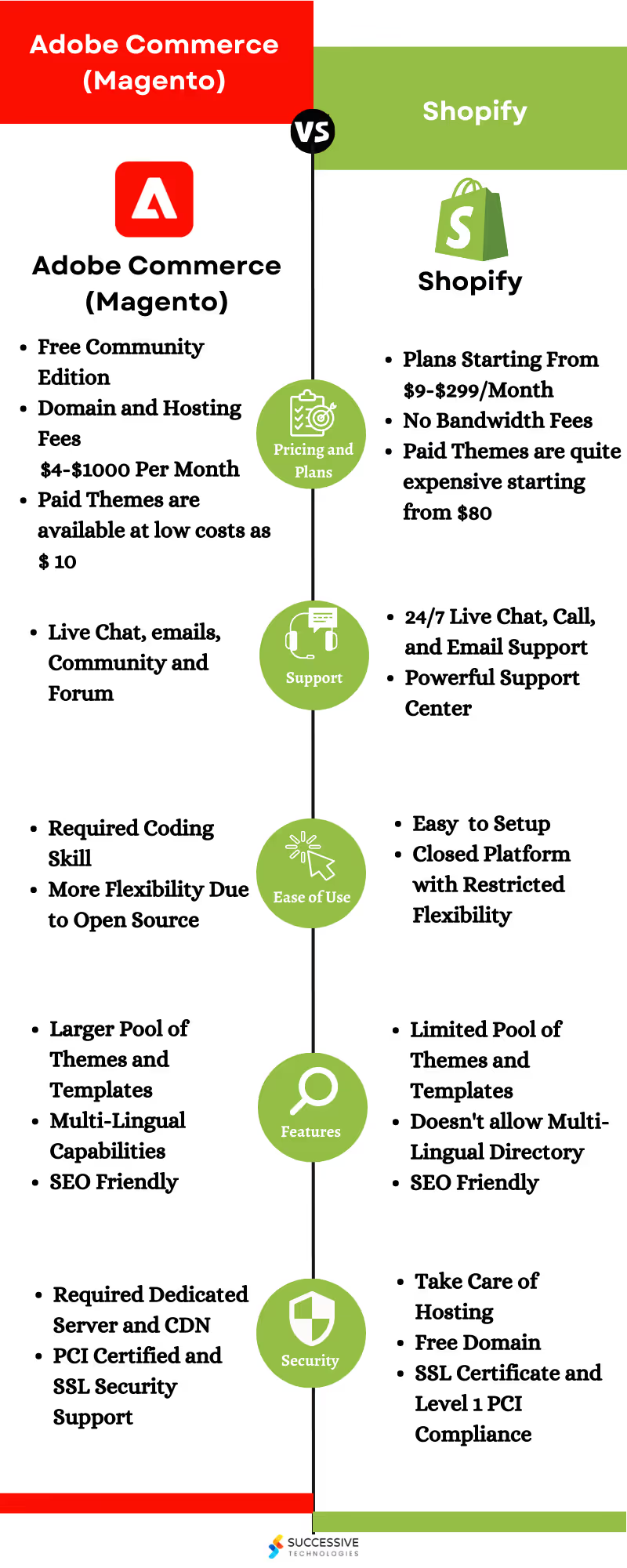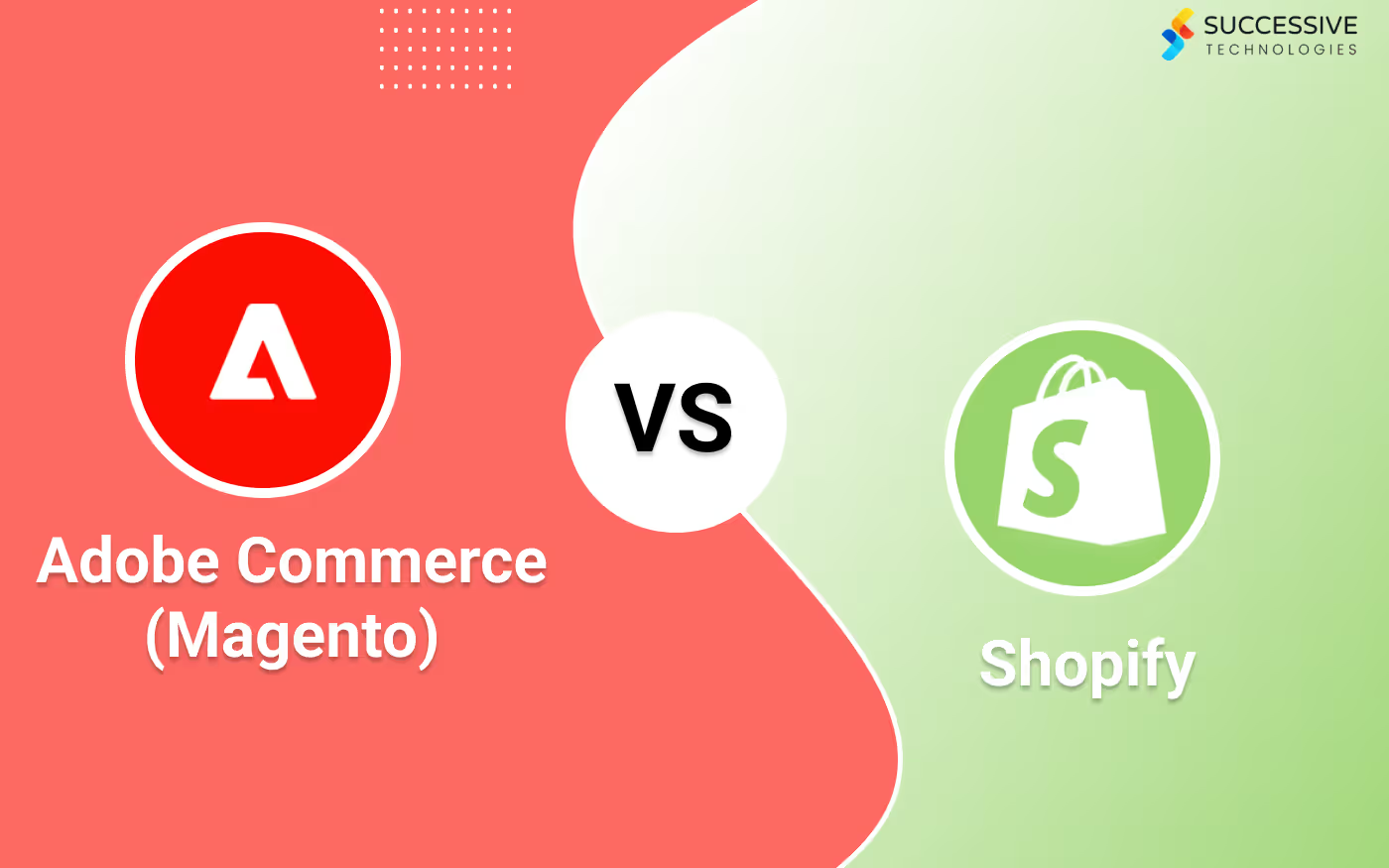When choosing an e-commerce platform, Adobe Commerce (formerly known as Magento) and Shopify are two of the most popular options. Both platforms offer a range of features and tools to help businesses build and manage their online stores, but they also have some significant differences. Here is a comparison of Adobe Commerce (Magento) and Shopify to help you decide which platform is best for your business. Before comparing each other, let’s discuss Adobe Commerce and Shopify.
Adobe Commerce and Its Benefits
Adobe Commerce is a powerful e-commerce platform that helps businesses build and manage online stores. It was formerly known as Magento but was rebranded as Adobe Commerce in 2018 when Adobe acquired it.Adobe Commerce offers a range of features and tools to help businesses sell their products and services online, including:
- Adobe Commerce platform is highly customizable that allows businesses to tailor their online stores to their specific needs. It offers a range of customization options, including custom integrations, third-party plugins, and custom code.
- Adobe Commerce is designed to handle large volumes of traffic and a wide range of products, making it a good choice for businesses with high-volume sales. It is also scalable, meaning it can grow with your business as your needs change.
- Adobe Commerce is optimized for mobile devices, ensuring that your online store is easy to use and navigate on smartphones and tablets.
- Adobe Commerce includes a range of marketing and SEO tools to help businesses promote their products and increase their online visibility.
- Adobe Commerce is a secure platform that helps protect your business and your customers' data. It offers a range of security features, including secure payment options and data encryption.
- Adobe Commerce has a large community of developers and users who contribute to the platform and offer support, as well as a range of resources and documentation.
By using Adobe Commerce, businesses can build and manage a professional and effective online store that helps them reach a wider audience and increase their sales.
Shopify and Its Benefits
Shopify is a cloud-based e-commerce platform that helps businesses build and manage online stores. It offers a range of features and tools to help businesses sell their products and services online, including:
- A user-friendly platform that is easy to set up and manage, making it a good choice for businesses without technical expertise.
- It offers a range of customization options, including customizable templates, themes, and design elements, as well as third-party plugins and integrations.
- Shopify is optimized for mobile devices, ensuring that your online store is easy to use and navigate on smartphones and tablets.
- It includes a range of marketing and SEO tools to help businesses promote their products and increase their online visibility.
- Shopify is a secure platform that helps protect your business and your customers' data. It offers a range of security features, including secure payment options and data encryption.
- Shopify has a large community of users and a range of resources and support options, including 24/7 support, tools, and integrations.
By using Shopify, businesses can build and manage a professional and effective online store that helps them reach a wider audience and increase their sales. It is a good choice for small to medium-sized businesses looking for an easy-to-use platform with various customization options.Also Read: Adobe Commerce (Magento) vs BigCommerce: Which One to Choose?
Head-to-Head Comparison- Adobe Commerce vs Shopify

Magento vs Shopify- Customization Options
One of the most significant differences between the two platforms is the level of customization available. Adobe Commerce (Magento) is a highly customizable e-commerce platform that allows businesses to tailor their online stores to their specific needs. It offers a range of customization options, including custom integrations, third-party plugins, and custom code. In contrast, Shopify is a more user-friendly platform that is easier to set up and manage but has fewer customization options.
Adobe Commerce vs Shopify- Scalability
Both (Magento) Adobe Commerce and Shopify are highly scalable platforms, but they have different approaches to scalability. Adobe Commerce (Magento) is designed to handle large volumes of traffic and a wide range of products, making it a good choice for businesses with high-volume sales. Shopify is also scalable but geared more toward small to medium-sized businesses. It may be better suited to handle large traffic volumes or an extensive product catalog.
Adobe Commerce vs Shopify- Pricing
(Magento) Adobe Commerce and Shopify have different pricing structures. Adobe Commerce (Magento) offers a range of pricing options, including free open-source and paid versions with additional features and support. The cost of using Adobe Commerce (Magento) can vary depending on the specific needs of your business and the level of customization required. On the other hand, Shopify offers a range of subscription-based plans with different features and pricing options.
Adobe Commerce vs Shopify- Design
Magento (Adobe Commerce) prefers to provide consumers with limitless flexibility and customization choices via a drag-and-drop builder and content editor. Users can create customized experiences to interact with particular audiences using the integrated customer segmentation tooling. Additionally, their product recommendation tool can make product recommendations based on customer preferences and product attributes.Shopify offers eight free, premium themes that cost between $150 and $350. Each design has theme settings that let users modify their website without knowing HTML or CSS, such as adding banners or changing colors.
Magento vs Shopify- Ease of Use
Another key difference between the two platforms is the ease of use. Adobe Commerce (Magento) is a more complex platform that requires more technical knowledge to set up and manage, making it better suited for businesses with in-house technical expertise or the resources to hire a developer. On the other hand, Shopify is a more user-friendly platform that is easier to set up and manage, making it a good choice for businesses without technical expertise.
Adobe Commerce vs Shopify- Sale
A robust point-of-sale (POS) system is available from Shopify with features for staff administration, inventory tracking, and unified analytics. Orders can be filled by local pickup, local delivery, buy online, pick up in-store (BOPIS), curbside, or through a fluid omnichannel procedure that merchants can design. A POS package with a card reader, receipt printer, and barcode scanner is also available to sellers at a subsidized price.In contrast to Shopify, Magento provides POS systems via plugins. It has built-in B2B capabilities because it serves large businesses and corporations. Customers may track quotes, manage their credit, define different buyer tiers, manage their company accounts, and more here.
Adobe Commerce vs Shopify- Support and Resources
(Magento) Adobe Commerce and Shopify offer their users a range of support and resources. Adobe Commerce (Magento) has a large community of developers and users who contribute to the platform and offer support, as well as a range of resources and documentation. Shopify also has a large community of users and a range of resources and support options, including 24/7 support and a range of tools and integrations.Also Related: Adobe Commerce (Magento) vs WooCommerce: Which One to Choose?
Bottom Line
Ultimately, the best eCommerce platform for your business will depend on your specific needs and goals. Adobe Commerce (Magento) is a more customizable and scalable platform better suited for larger businesses with technical expertise. At the same time, Shopify is a more user-friendly platform better suited for small to medium-sized businesses. By considering your business needs and goals, you can choose the best platform for you: Adobe Commerce or Shopify.
.avif)










.jpg)









